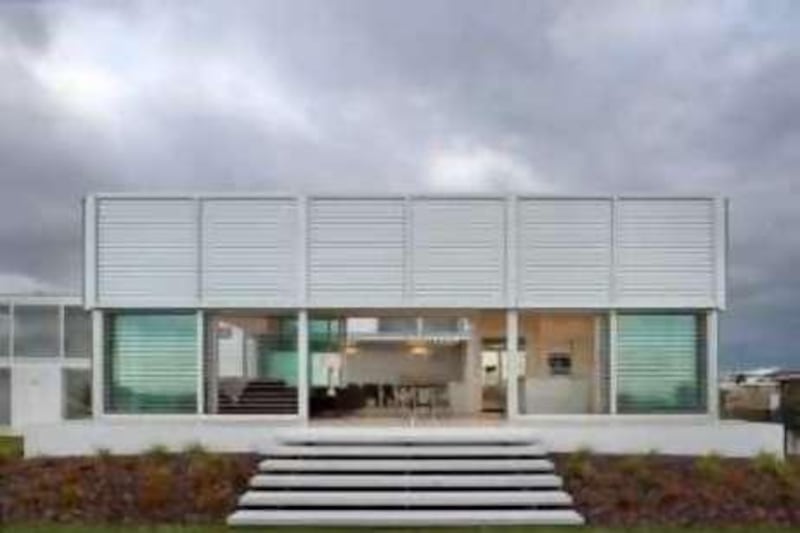This louvre-covered holiday home in New Zealand, designed by the architecture firm Godward Guthrie, has a modern and fresh feel that makes a feature of its harsh environment. New Zealand is a forgotten paradise. Or at least it is easy to imagine it that way. Photogenic shots of isolated, lush holiday spots on cliffs or submerged in forests can easily give an impression of a benign, gentle environment. Yet beneath this idyllic daydream the island nation, scattered with active volcanoes and hemmed in by rough seas, can be a harsh environment, one which its holiday architecture has needed to adapt.
Omaha Beach, about an hour north of Auckland, has constant blustery winds sweeping across austere desert-like dunes. Still, its long, white-sand beach and proximity to a large city have ensured that it remains a popular beach retreat. Huddled alongside the beach, this louvre-clad holiday home designed by the Auckland architecture firm Godward Guthrie, squares off to the wind, its design making a feature of its harsh environment.
Bracing itself against the wind, the house is sheathed in aluminium louvres. The louvres allow the house to be completely locked down and secured when the owners are away but then also allows for varying degrees of openness when they are there. Two rows of louvres line the front of the house and all of the fins are adjustable depending on the light, or need for privacy. The bottom row will also hoist up underneath the top row so that the entire ground floor living area can be thrown open. Each block of louvres works individually, so various patterns of habitation can be recorded in the pattern of the stripes.
This also highlights another challenge faced by the architect Julian Guthrie. Directly in front of the house is a public walkway along the dunes, and Omaha, having become a bit of an architectural tour, sees more passers-by rubbernecking at the houses than staring out at the beach. While the house may be an attraction for onlookers on the promenade, the way the louvres resemble slits of Venetian blinds is a clever pun hinting at an image of a noisy neighbour peering through the slats busily surveying the scene. The house watches the watchers.
Aluminium was chosen for its robustness, particularly against wind-driven sand that would scour exposed timber. The client also had a penchant for gadgets, and the metallic technology of the automated louvres aligned well with the clean and beachy character within the house. The wide pivot door in the entry is one of these gadgets. Operated at the touch of a button, it does have distinct advantages. The door never slams, for one thing, which in windy Omaha is surely a blessing. And you can get grandeur without the worrying about the heaviness. This door is hands-free - an aspect must make hauling groceries or deck chairs or children inside much easier as well as maintaining security.
This flexible functionality is found throughout the house. Walking along the glass corridor from the entry to the living room, Julian Guthrie explains how the floor level was raised by 1200mm to maximise views to the beach over the low-lying dunes in front of the house. This also gave ample space underneath to house the water tanks out of sight. The living pavilion is a rectangular space that buffers the space between the beach and the inner courtyard. Despite the house being large, the living area is a reasonably contained space: a cosy square for living; another cube for the kitchen at the other end; and then a space between the two for dining. If the weather is fine, this entire space spills out onto the large deck overlooking the beach. If the weather is less than ideal the owners can make use of the sheltered courtyard on the other side.
This house balances expertly between showing off the view and not showing too much of the occupants inside. Coupled with the resolutely modern look, the automation, and the palette of white and grey, this house has a particularly modern and fresh feel that contrasts well with its harsh environment. * Nicole Stock





